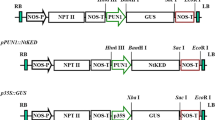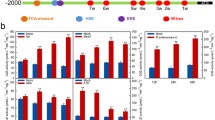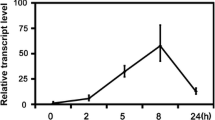Abstract
Analysis of the promoters of defense-related genes is valuable for determining stress signaling and transcriptional activation during pathogen infection. Here, we have isolated and functionally characterized the promoter region of the pepper (Capsicum annuum) pectin methylesterase inhibitor 1 (CaPMEI1) gene in transiently transformed tobacco plants and stably transformed Arabidopsis plants. Among four 5′ deletion constructs analyzed, the −958-bp CaPMEI1 promoter induced a high level of GUS reporter activity in tobacco leaf tissue, driven by pathogen infection as well as by ethylene and methyl jasmonate (MeJA) treatment. The 204-bp region from −958 bp to −754 bp of the CaPMEI1 promoter is responsible for the stress-responsive expression. In addition, the pepper transcription factor CARAV1 activated the CaPMEI1 promoter in tobacco leaves, whereas the transcription factor CAbZIP1 did not. In the transgenic Arabidopsis plants, the −958 bp CaPMEI1 promoter was functionally regulated by developmental cues, bacterial and oomycete pathogen infections, and treatment with ethylene and MeJA. Histochemical GUS staining analyses of Arabidopsis tissues revealed that the CaPMEI1 promoter was mainly activated in leaf veins in response to various biotic and abiotic stimuli. Together, these results suggest that CaPMEI1 promoter activation may be a critical molecular event for host defense response and ethylene- and MeJA-mediated CaPMEI1 gene expression.








Similar content being viewed by others
Abbreviations
- CaPMEI1:
-
Capsicum annuum pectin methylesterase 1
- GUS:
-
β-Glucouronidase
- HR:
-
Hypersensitive response
- MeJA:
-
Methyl jasmonate
- MS:
-
Murashige and Skoog
- PR:
-
Pathogenesis related
- Pst:
-
Pseudomonas syringae pv. tomato
- Xcv:
-
Xanthomonas campestric pv. vesicatoria
References
An SH, Choi HW, Hwang IS, Hong JK, Hwang BK (2008a) A novel pepper membrane-located receptor-like protein gene CaMRP1 is required for disease susceptibility, methyl jasmonate insensitivity and salt tolerance. Plant Mol Biol 67:519–533
An SH, Sohn KH, Choi HW, Hwang IS, Lee SC, Hwang BK (2008b) Pepper pectin methylesterase inhibitor protein CaPMEI1 is required for antifungal activity, basal disease resistance and abiotic stress tolerance. Planta 228:61–78
Baker B, Zambryski P, Staskawicz B, Dinesh-Kumar SP (1997) Signaling in plant–microbe interactions. Science 276:726–733
Barrero C, Royo J, Grijota-Martinez C, Gaye C, Paul W, Sanz S, Steinbiss HH, Hueros G (2009) The promoter of ZmMRP-1, a maize transfer cell-specific transfer cell-specific transcriptional activator, is induced at solute exchange surfaces and responds to transport demands. Planta 229:235–247
Berrocal-Lobo M, Molina A (2004) Ethylene response factor 1 mediates Arabidopsis resistance to the soil-borne fungus Fusarium oxysporum. Mol Plant Microbe Interact 17:763–770
Berrocal-Lobo M, Molina A, Solano R (2002) Constitutive expression of ETHYLENE-REPONSE-FACTOR1 in Arabidopsis confers resistance to several necrotrophic fungi. Plant J 29:23–32
Bosch M, Cheung AY, Hepler PK (2005) Pectin methylesterase, a regulator of pollen tube growth. Plant Physiol 138:1334–1346
Bradford MM (1976) A rapid sensitive method for the quantification of microgram quantities of protein utilizing the principle of protein–dye binding. Anal Biochem 72:248–254
Breda C, Sallaud C, El-Turk J, Buffard D, de Kozak I, Esnault R, Kondorosi A (1996) Defense reaction in Medicago sativa: a gene encoding a class 10 PR protein is expressed in vascular bundles. Mol Plant Microbe Interact 9:713–719
Brummell DA, Harpster MH (2001) Cell wall metabolism in fruit softening and quality and its manipulation in transgenic plants. Plant Mol Biol 47:311–340
Chen C, Chen Z (2000) Isolation and characterization of two pathogen- and salicylic acid-induced genes encoding WRKY DNA-binding proteins from tobacco. Plant Mol Biol 42:387–396
Cheong YH, Chang HS, Gupta R, Wang X, Zhu T, Luan S (2002) Transcriptional profiling reveals novel interactions between wounding, pathogen, abiotic stress, and hormonal responses in Arabidopsis. Plant Physiol 129:661–677
Choi MS, Yoon IS, Rhee Y, Choi SK, Lim SH, Won SY, Lee YH, Choi HS, Lee SC, Kim KH, Lomonossoff G, Sohn SH (2008) The effect of Cucumber mosaic virus 2b protein to transient expression and transgene silencing mediated by agro-infiltration. Plant Pathol J 24:296–304
Chung E, Oh SK, Park JM, Choi D (2007) Expression and promoter analyses of pepper CaCDPK4 (Capsicum annuum calcium dependent protein kinase 4) during plant defense response to incompatible pathogen. Plant Pathol J 23:76–89
Cinege G, Louis S, Hänsch R, Schnitzler JP (2009) Regulation of isoprene synthase promoter by environmental and internal factors. Plant Mol Biol 69:593–604
Clough SJ, Bent AF (1998) Floral dip: a simplified method for Agrobacterium-mediated transformation of Arabidopsis thaliana. Plant J 16:735–743
Denekamp M, Smeekens SC (2003) Integration of wounding and osmotic stress signals determines the expression of the AtMYB102 transcription factor gene. Plant Physiol 132:1415–1423
Di Matteo A, Giovane A, Raiola A, Camardella L, Bonivento D, De Lorenzo G, Cervone F, Bellincampi D, Tsernoglou D (2005) Structural basis for the interaction between pectin methylesterase and a specific inhibitor protein. Plant Cell 17:849–858
Du L, Chen Z (2000) Identification of genes encoding receptor-like protein kinases as possible targets of pathogen- and salicylic acid-induced WRKY DNA-binding proteins in Arabidopsis. Plant J 24:837–847
Eyal Y, Meller Y, Lev-Yadun S, Fluhr R (1993) A basic-type PR-1 promoter directs ethylene responsiveness, vascular and abscission zone-specific expression. Plant J 4:225–234
Galis I, Simek P, Narisawa T, Sasaki M, Horiguchi T, Fukuda H, Matsuoka K (2006) A novel R2R3 MYB transcription factor NtMYBJS1 is a methyl jasmonate-dependent regulator of phenylpropanoid-conjugate biosynthesis in tobacco. Plant J 46:573–592
Giovane A, Servillo L, Balestrieri C, Raiola A, D’Avino R, Tamburrini M, Ciardiello MA, Camardella L (2004) Pectin methylesterase inhibitor. Biochim Biophys Acta 1696:245–252
Hart CM, Nagy F, Meins F Jr (1993) A 61-bp enhancer element of the tobacco beta-1, 3-glucanase B gene interacts with one or more regulated nuclear proteins. Plant Mol Biol 21:121–131
Hartmann U, Sagasser M, Mehrtens F, Stracke R, Weisshaar B (2005) Differential combinatorial interactions of cis-acting elements recognized by R2R3-MYB, BZIP, and BHLH factors control light-responsive and tissue-specific activation of phenylpropanoid biosynthesis genes. Plant Mol Biol 57:155–171
Higo K, Ugawa Y, Iwamoto M, Korenaga T (1999) Plant cis-acting regulatory DNA elements (PLACE) database: 1999. Nucleic Acids Res 27:297–300
Hong JK, Hwang BK (2006) Promoter activation of pepper class II basic chitinase gene, CAChi2, and enhanced bacterial disease resistance and osmotic stress tolerance in the CAChi2-overexpressing Arabidopsis. Planta 223:433–448
Hong JK, Lee SC, Hwang BK (2005) Activation of pepper basic PR-1 gene promoter during defense signaling to pathogen, abiotic and environmental stresses. Gene 356:169–180
Irifune K, Nishida T, Egawa H, Nagatani A (2004) Pectin methylesterase inhibitor cDNA from kiwi fruit. Plant Cell Rep 23:333–338
Itzhaki H, Woodson WR (1993) Characterization of an ethylene-responsive glutathione S-transferase gene cluster in carnation. Plant Mol Biol 22:43–58
Itzhaki H, Maxson JM, Woodson WR (1994) An ethylene-responsive enhancer element is involved in the senescence-related expression of the carnation glutathione-S-transferase (GST1) gene. Proc Natl Acad Sci USA 91:8925–8929
Jefferson RA, Kavanagh TA, Bevan MW (1987) GUS fusions: β-glucouronidase as a sensitive and versatile gene fusion marker in higher plants. EMBO J 13:3901–3907
Jung HW, Kim KD, Hwang BK (2005) Identification of pathogen-responsive regions in the promoter of a pepper lipid transfer protein gene (CALTPI) and the enhanced resistance of the CALTPI transgenic Arabidopsis against pathogen and environmental stresses. Planta 221:361–373
Kagaya Y, Ohmiya K, Hattori T (1999) RAV1, a novel DNA-binding protein, binds to bipartite recognition sequence through two distinct DNA-binding domains uniquely found in higher plants. Nucleic Acids Res 27:470–478
Kalde M, Barth M, Somssich IE, Lippok B (2003) Members of the Arabidopsis WRKY group III transcription factors are part of different plant defense signaling pathways. Mol Plant Microbe Interact 16:295–305
Kim YJ, Hwang BK (2000) Pepper gene encoding a basic pathogenesis-related 1 protein is pathogen and ethylene inducible. Physiol Plant 108:51–60
Kim SH, Hong JK, Lee SC, Sohn KH, Jung HW, Hwang BK (2004) CAZFP1, Cys2/His2-type zinc-finger transcription factor gene functions as a pathogen-induced early-defense gene in Capsicum annuum. Plant Mol Biol 55:883–904
Kim SY, Kim YC, Lee JH, Oh SK, Chung E, Lee S, Lee YH, Choi D, Park JM (2005) Identification of a CaRAV1 possessing an AP2/ERF and B3 DNA-binding domain from pepper leaves infected with Xanthomonas axonopodis pv. glycines 8ra by differential display. Biochim Biophys Acta 1729:141–146
King EO, Ward MK, Raney DE (1954) Two simple media for the demonstration of phycocyanin and fluorescin. J Lab Clin Med 44:111–121
Kunkel BN, Brooks DM (2002) Cross talk between signaling pathways in pathogen defense. Curr Opin Plant Biol 5:325–331
Lee SC, Hwang BK (2006) Identification and deletion analysis of the promoter of the pepper SAR8.2 gene activated by bacterial infection and abiotic stresses. Planta 224:255–267
Lee MW, Qi M, Yang Y (2001) A novel jasmonic acid-inducible rice myb gene associates with fungal infection and host cell death. Mol Plant Microbe Interact 14:527–535
Lee JH, Kim SH, Jung YH, Kim JA, Lee MO, Choi PG, Choi W, Kim KN, Jwa NS (2005) Molecular cloning and functional analysis of rice (Oryza sativa L.) OsNDR1 on defense signaling pathway. Plant Pathol J 21:149–157
Lee SC, Choi HW, Hwang IS, Choi du S, Hwang BK (2006) Functional roles of the pepper pathogen-induced bZIP transcription factor, CAbZIP1, in enhanced resistance to pathogen infection and environmental stresses. Planta 224:1209–1225
Lescot M, Déhais P, Thijs G, Marchal K, Moreau Y, Van de Peer Y, Rouzé P, Rombauts S (2002) PlantCARE, a database of plant cis-acting regulatory elements and a portal to tools for in silico analysis of promoter sequences. Nucleic Acids Res 30:325–327
Li Y, Wu Z, Ma N, Gao J (2009) Regulation of the rose Rh-PIP2;1 promoter by hormones and abiotic stresses in Arabidopsis. Plant Cell Rep 28:185–196
Lionetti V, Raiola A, Camardella L, Giovane A, Obel N, Pauly M, Favaron F, Cervone F, Bellincampi D (2007) Overexpression of pectin methylesterase inhibitors in Arabidopsis restricts fungal infection by Botrytis cinerea. Plant Physiol 143:1871–1880
Lippok B, Birkenbihl RP, Rivory G, Brummer J, Schmelzer E, Logemann E, Somssich IE (2007) Expression of AtWRKY33 encoding a pathogen- or PAMP-responsive WRKY transcription factor is regulated by a composite DNA motif containing W box elements. Mol Plant Microbe Interact 20:420–429
Micheli F (2001) Pectin methylesterases: cell wall enzymes with important roles in plant physiology. Trends Plant Sci 6:414–419
Montalvo-Hernández L, Piedra-Ibarra E, Gómez-Silva L, Lira-Carmona R, Acosta-Gallegos JA, Vazquez-Medrano J, Xoconostle-Cázares B, Ruíz-Medrano R (2008) Differential accumulation of mRNA in drought-tolerant and susceptible common bean cultivars in response to water deficit. New Phytol 177:102–113
Montgomery J, Goldman S, Deikman J, Margossian L, Fischer RL (1993) Identification of an ethylene-responsive region in the promoter of a fruit ripening gene. Proc Natl Acad Sci USA 90:5939–5943
Murashige T, Skoog F (1962) A revised medium for rapid growth and bioassays with tobacco cultures. Physiol Plant 15:474–497
Nishiuchi T, Shinshi H, Suzuki K (2004) Rapid and transient activation of transcription of the ERF3 gene by wounding in tobacco leaves: possible involvement of NtWRKYs and autorepression. J Biol Chem 279:55355–55361
Ohme-Takagi M, Shinshi H (1990) Structure and expression of a tobacco beta-1, 3-glucanase gene. Plant Mol Biol 15:94
Peaucelle A, Louvet R, Johansen JN, Höfte H, Laufs P, Pelloux J, Mouille G (2008) Arabidopsis phyllotaxis is controlled by the methyl-esterification status of cell-wall pectins. Curr Biol 18:1943–1948
Petersen M, Brodersen P, Naested H, Andreasson E, Lindhart U, Johansen B, Nielsen HB, Lacy M, Austin MJ, Parker JE, Sharma SB, Klessig DF, Martienssen R, Mattsson O, Jensen AB, Mundy J (2000) Arabidopsis map kinase 4 negatively regulates systemic acquired resistance. Cell 103:1111–1120
Pilling J, Willmitzer L, Fisahn J (2000) Expression of a Petunia inflata pectin methylesterase in Solanum tuberosum L. enhances stem elongation and modifies cation distribution. Planta 210:391–399
Rawat R, Xu ZF, Yao KM, Chye ML (2005) Identification of cis-elements for ethylene and circadian regulation of the Solanum melongena gene encoding cysteine proteinase. Plant Mol Biol 57:629–643
Röckel N, Wolf S, Kost B, Rausch T, Greiner S (2008) Elaborate spatial patterning of cell-wall PME and PMEI at the pollen tube tip involved PMEI endocytosis, and reflects the distribution of esterified and de-esterified pectins. Plant J 53:133–143
Rouster J, Leah R, Mundy J, Cameron-Mills V (1997) Identification of a methyl jasmonate-responsive region in the promoter of a lipoxygenase 1 gene expressed in barley grain. Plant J 11:513–523
Rushton PJ, Somssich IE (1998) Transcriptional control of plant genes responsive to pathogens. Curr Opin Plant Biol 1:311–315
Rushton PJ, Torres JT, Parniske M, Wernert P, Hahlbrock K, Somssich IE (1996) Interaction of elicitor-induced DNA-binding proteins with elicitor response elements in the promoters of parsley PR1 genes. EMBO J 15:5690–5700
Rushton PJ, Reinstadler A, Lipka V, Lippok B, Somssich IE (2002) Synthetic plant promoters containing defined regulatory elements provide novel insights into pathogen- and wound-induced signaling. Plant Cell 14:749–762
Sablowski RW, Moyano E, Culianez-Macia FA, Schuch W, Martin C, Bevan M (1994) A flower-specific Myb protein activates transcription of phenylpropanoid biosynthetic genes. EMBO J 13:128–137
Seo HS, Song JT, Cheong JJ, Lee YH, Lee YW, Hwang I, Lee JS, Choi YD (2004) Jasmonic acid carboxyl methyltransferase: a key enzyme for jasmonate-regulated plant responses. Proc Natl Acad Sci USA 98:4788–4793
Sessa G, Meller Y, Fluhr R (1995) A GCC element and a G-box motif participate in ethylene-induced expression of the PRB-1b gene. Plant Mol Biol 28:145–153
Singh K, Foley RC, Onate-Sanchez L (2002) Transcription factors in plant defense and stress responses. Curr Opin Plant Biol 5:430–436
Sohn KH, Lee SC, Jung HW, Hong JK, Hwang BK (2006) Expression and functional roles of the pepper pathogen-induced transcription factor RAV1 in bacterial disease resistance, and drought and salt stress tolerance. Plant Mol Biol 61:897–915
Steffens NO, Galuschka C, Schindler M, Bulow L, Hehl R (2004) AthaMap: an online resource for in silico transcription factor binding sites in the Arabidopsis thaliana genome. Nucleic Acids Res 32:D368–D372
Urao T, Yamaguchi-Shinozaki K, Urao S, Shinozaki K (1993) An Arabidopsis myb homolog is induced by dehydration stress and its gene product binds to the conserved MYB recognition sequence. Plant Cell 5:1529–1539
Vailleau F, Daniel X, Tronchet M, Montillet JL, Triantaphylides C, Roby D (2002) A R2R3-MYB gene, AtMYB30, acts as a positive regulator of the hypersensitive cell death program in plants in response to pathogen attack. Proc Natl Acad Sci USA 99:10179–10184
Wen F, Zhu Y, Hawes MC (1999) Effect of pectin methylesterase gene expression on pea root development. Plant Cell 11:1129–1140
Yang Y, Li R, Qi M (2000) In vivo analysis of plant promoters and transcription factors by agro-infiltration of tobacco leaves. Plant J 22:543–551
Yu D, Chen C, Chen Z (2001) Evidence for an important role of WRKY DNA-binding proteins in the regulation of NPR1 gene expression. Plant Cell 13:1527–1540
Zhou J, Tang X, Martin GB (1997) The Pto kinase conferring resistance to tomato bacterial speck disease interacts with proteins that bind a cis-element of pathogenesis-related genes. EMBO J 16:3207–3218
Acknowledgments
This research was supported by a grant (CG1133) from the Crop Functional Genomics Center of the 21st Century, the Frontier Research Program funded by the Ministry of Science and Technology of the Republic of Korea, and a grant (20070401034028) from the BioGreen21 Program, Rural Development Administration, Korea.
Author information
Authors and Affiliations
Corresponding author
Rights and permissions
About this article
Cite this article
An, S.H., Choi, H.W., Hong, J.K. et al. Regulation and function of the pepper pectin methylesterase inhibitor (CaPMEI1) gene promoter in defense and ethylene and methyl jasmonate signaling in plants. Planta 230, 1223–1237 (2009). https://doi.org/10.1007/s00425-009-1021-4
Received:
Accepted:
Published:
Issue Date:
DOI: https://doi.org/10.1007/s00425-009-1021-4




